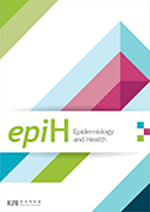Epidemiological characteristics and risk factors of suspected and confirmed mpox cases during the 2022-2023 epidemic in the Capital Region, Republic of Korea
- 한국역학회
- Epidemiology and Health
- 46
-
2024.011 - 6 (6 pages)
-
DOI : 10.4178/epih.e2024092
- 0

OBJECTIVES: This study investigated the general characteristics of laboratory-confirmed mpox patients in the Capital Region of Korea, as well as the risk factors for mpox infection, particularly focusing on the characteristics of polymerase chain reaction (PCR)-positive and PCR-negative cases. METHODS: We investigated 160 adults, excluding 4 minors, from 164 suspected mpox patients reported in Seoul, Gyeonggi, Incheon, and Gangwon from June 21, 2022 to October 31, 2023. Data were collected via telephone and face-to-face interviews. A statistical analysis of the general characteristics of the infection was conducted using frequency analysis and logistic regression. RESULTS: Of the 160 suspected cases of mpox, 59.3% (n= 95) tested positive via mpox-PCR. Among the confirmed cases, 97.9% (n= 93) were male. PCR-positive patients typically presented with genital and anal skin rashes or mucosal lesions, accompanied by pain. Additionally, 35.5% (n= 33) of the male patients had human immunodeficiency virus (HIV) infections. Most confirmed cases (94.7%, 90/95) were believed to have contracted mpox through sexual contact during the maximal incubation period of 21 days prior to symptom onset, with a significant number reporting same-sex or casual contact. The most commonly collected and highest-yielding specimens from PCR-positive patients were from skin or mucosal lesions, whereas blood samples demonstrated the lowest percent positivity. CONCLUSIONS: In the Capital Region, most PCR-positive cases were male patients in their 30s who had sexual contacts and exhibited symptoms, aligning with findings from previous studies. These results provide a foundation for the differential diagnosis concerning mpox infection and the selection of PCR-test samples in clinical settings.
INTRODUCTION
MATERIALS AND METHODS
RESULTS
DISCUSSION
NOTES
REFERENCES
(0)
(0)